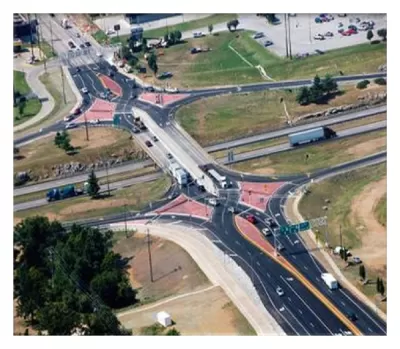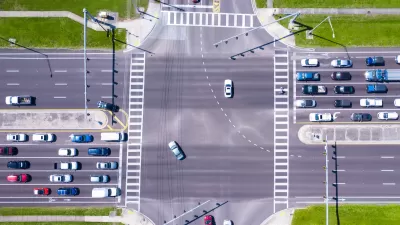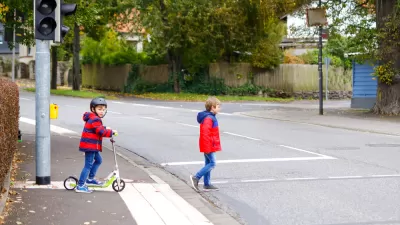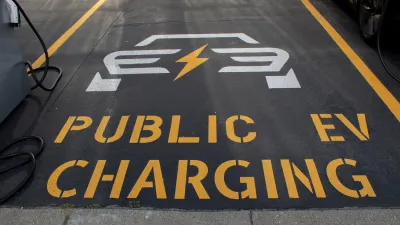The unusual design improves traffic flow and reduces the danger of head-on collisions as cars enter the I-5 freeway.

If you've ever wondered what it's like to drive on the left side of the road, you can now experience it in Washington State. The "diverging diamond" interchange in Laceyopened in August of 2020, with final touches scheduled to be completed early this year. The design, writes Mike Lindblom in the Seattle Times, reduces possible collision points by nearly half and speeds up the time it takes drivers to reach the I-5 freeway. Putting cars on the left side eliminates the need for a traffic light as drivers turn left to enter the freeway and eases the flow of traffic. According to Blake Knoblauch, executive director of the Lacey South Sound Chamber of Commerce, "drivers who previously waited through two or three light cycles now usually make it through on the first green light."
Popularized by Gilbert Chlewicki of Advanced Traffic Solutions, the diverging diamond interchangeis slowly picking up steam in the United States, with around 150 constructed to date. A study of the design that analyzed 26 such interchanges found that the number of collisions declined by 37%, with the number of injury crashes falling by more than 50%.
The interchange takes a bit of getting used to for some drivers, who fear getting hit or have trouble reaching the appropriate lane for entering the freeway. Bicycling conditions "remain hostile," says Lindblom, an issue acknowledged by Chlewicki. The project is primarily a measure to accommodate projected traffic growth through 2025 as local authorities plan for more expansions to facilitate truck traffic to local warehouses.
FULL STORY: A novel I-5 interchange in Lacey lets motorists drive on the left side of the road

Trump Administration Could Effectively End Housing Voucher Program
Federal officials are eyeing major cuts to the Section 8 program that helps millions of low-income households pay rent.

Planetizen Federal Action Tracker
A weekly monitor of how Trump’s orders and actions are impacting planners and planning in America.

Ken Jennings Launches Transit Web Series
The Jeopardy champ wants you to ride public transit.

Rebuilding Smarter: How LA County Is Guiding Fire-Ravaged Communities Toward Resilience
Los Angeles County is leading a coordinated effort to help fire-impacted communities rebuild with resilience by providing recovery resources, promoting fire-wise design, and aligning reconstruction with broader sustainability and climate goals.

When Borders Blur: Regional Collaboration in Action
As regional challenges outgrow city boundaries, “When Borders Blur” explores how cross-jurisdictional collaboration can drive smarter, more resilient urban planning, sharing real-world lessons from thriving partnerships across North America.

Philadelphia Is Expanding its Network of Roundabouts
Roundabouts are widely shown to decrease traffic speed, reduce congestion, and improve efficiency.
Urban Design for Planners 1: Software Tools
This six-course series explores essential urban design concepts using open source software and equips planners with the tools they need to participate fully in the urban design process.
Planning for Universal Design
Learn the tools for implementing Universal Design in planning regulations.
Ada County Highway District
Clanton & Associates, Inc.
Jessamine County Fiscal Court
Institute for Housing and Urban Development Studies (IHS)
City of Grandview
Harvard GSD Executive Education
Toledo-Lucas County Plan Commissions
Salt Lake City
NYU Wagner Graduate School of Public Service





























